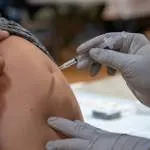(Just The News) Symptoms attributed to “long COVID” may have nothing to do with the coronavirus infection in adolescents and young adults, according to a new peer-reviewed study that calls into question massive federal outlays for research into the largely self-reported condition marked by fatigue, shortness of breath and brain fog.
Published Thursday in the Journal of the American Medical Association Network Open, the “prospective cohort study” tracked hundreds of Norwegians ages 12-25, not hospitalized, who underwent extensive examinations when they were tested for COVID and then again at a six-month followup.
Norwegian, Swedish, British, Chinese and Australian researchers found little difference between infected and uninfected individuals who met the World Health Organization’s definition for “post-COVID-19 condition,” the international name for long COVID, at the six-month followup.
The “prevalence” rate for the infected group was 49%, and for the uninfected group, 47%. The mean age for both was about 18.
“PCC was not associated with biological markers specific to viral infection, but with initial symptom severity,” the strongest risk factor, “and psychosocial factors” including “low physical activity” and “loneliness.” Severity correlated with “personality traits,” the researchers found.
Heatmap of correlations between symptoms and other traits among patients with post-covid syndromeshttps://t.co/puvdqUUGnM https://t.co/3uGoaatl67 pic.twitter.com/98k2Yb58X5
— Infectious Disease Ethics (@ID_ethics) March 31, 2023
The study echoes “retrospective cohort studies” cited in a recent Slate review that found long-COVID symptoms are far less common, durable or severe than often portrayed by federal officials and activists, and aren’t necessarily tied to infection or worse than other post-infection conditions.
Once feared as a “mass disabling event,” long COVID had no discernible effect on disability claims in the first two years of the pandemic, science journalist Jeff Wise wrote. It formed the basis of only a few successful claims a month to the New York State Insurance Fund after hundreds of approvals in spring 2020.
Wise faulted an early and influential University of Washington study that estimated a 30% rate of “persistent symptoms” based on a questionnaire sent to adult patients three to nine months later. Survey-based approaches may suffer from selection bias and document symptoms that predate infection, he wrote.
“Up to” 30% is also the uncredited estimate cited by the Solve Long COVID Initiative, part of a nonprofit that raises money to study post-infection illnesses.
In an August video featuring elderly and young adults and children, that nonprofit called long COVID a “physical disorder” that “causes crippling fatigue that may last a lifetime.” Showing its influence with federal officials, the initiative nabbed the CDC’s Elizabeth Unger, chief of chronic viral diseases, for its webinar last week.
The CDC published an even higher estimate: 36% in a study of George Washington University that lacked a control group and was not peer-reviewed. The agency claimed the general population figure could be as high as 80%.
Congress gave federal agencies a vested interest in portraying long COVID as a unique threat. Lawmakers appropriated $1.15 billion for the National Institutes of Health in December 2020 to study “the prolonged health consequences of SARS-CoV-2 infection,” then-NIH Director Francis Collins said when making the first series of “Research Opportunity Announcements” two years ago.
Among the topics to be studied: “the underlying biological cause of these prolonged symptoms.” Collins said NIH expected the research to “enhance our knowledge of the basic biology of how humans recover from infection” for both COVID and other “chronic post-viral syndromes.”
NIH didn’t respond to Just the News queries about the implications of the JAMA Network Open study and long COVID research reviewed by Slate.
The new JAMA Network Open study sought to identify factors behind both long COVID and a subset of clinically “sparse” cases it calls “post-infective fatigue syndrome,” which previous studies have found in “the aftermath of a wide array of infectious diseases” at a rate of 10-15%.
PIFS has a more specific international definition than does long COVID, the researchers said, and they found a correspondingly lower rate of PIFS: 14% in the positive group and 8% in the negative.
Most symptoms had overlapping confidence intervals between the two groups, though “some dimensions of fatigue and ear-nose-throat symptoms were more common” among those with documented infections, according to the paper. Crucially, “SARS-CoV-2 status was not associated with either PCC or PIFS at 6 months.”






